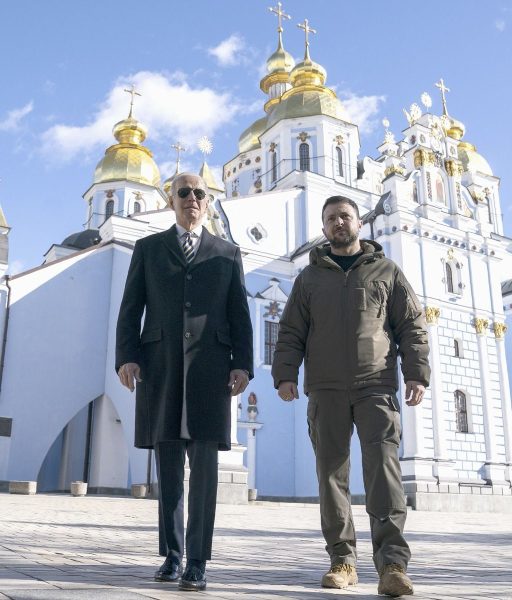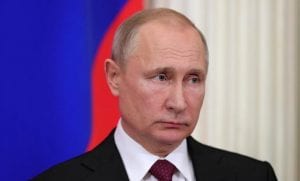
In Ukraine war, tide has turned in one year; Putin is on backfoot
The ‘surprise’ visit by US President Joe Biden to Kyiv earlier this week confirms the West’s active backing for Ukraine

When Russia invaded Ukraine nearly a year ago, on February 24, 2022, few foresaw the conflict continuing this long. Most (including this writer) expected a quick jab by Russian President Vladimir Putin at Ukraine with the limited aim of dissuading Kyiv from joining the Western military alliance, NATO.
But the invasion has turned into an intense battle of attrition with neither appearing to back down.
One can understand Russia, a much bigger power than Ukraine, muscling in and staying there. But Ukraine’s enduring resistance has turned the tables on Moscow. This has been made possible by the US and its European allies’ support for Ukraine, by supplying it with weapons and providing logistics help.
March 8, 2022: How far will Putin go in Ukraine? Georgia may hold the answers
According to reports, the US, UK and Germany have sent battle-tanks including the Abrams, Challengers and Leopards tanks. Armoured vehicles like the US’s Stryker too have made it to Ukraine. Besides these are the Patriot missile systems and the Nasams (National Advanced Surface-to-Air missiles. The US’s Long-range Himar rockets and Howitzers too are in Ukraine, not to forget drones and anti-tank weapons.
Active Western backing
The “surprise” visit by US President Joe Biden to Kyiv earlier this week confirms the West’s active backing for Ukraine. Biden announced an extra $500 million worth military aid to Ukraine during his visit. The EU, too, simultaneously said it would hike its aid to Ukraine with a view to ensuring a steady supply of ammunition to its army.

The contours of the conflict have changed as a result. What started off as Putin’s localised and limited attempt to rap Ukraine President Volodymyr Zelensky’s knuckle has turned into a larger geopolitical battle between the US-led West on the one side and Russia, backed by China, on the other.
The balance of power which was initially in Russia’s favour now appears to have shifted towards Ukraine. The US strategy, which initially pushed for NATO presence in Ukraine, has been expanded with a view to cornering Russia. It would not be wrong to conclude that Putin may have actually walked into a US trap by invading Ukraine.
May 6, 2022: Whatever has happened to the war in Ukraine? Why is it not ending?
Though Russia under Putin has been belligerent in the Caucasian region that was once part of the Soviet Union, it is a far cry from the time when it was part of the demised superpower.
Aggressive Putin
A militarily suave and aggressive Putin, who came to power in 1999, over the next few years subjugated Chechnya, which had declared independence from Russia in 1991. He first brought back direct control of Chechnya in 2000 and, 17 years later, reintegrated it into Russia. Clearly, Putin was not one to be pushed around nor a leader in awe of the West, like his predecessor Boris Yeltsin.
Putin again showed he meant business when, in 2008, Russia sent its military into Georgia and put down an anti-Moscow regime there in a matter of days. The Western world, which was lulled into complacency after the disintegration of the Soviet Union, did not take these developments seriously.
It was in 2014 that the US realised that Russia was rising from the Soviet ashes, when Putin intervened in the Syrian civil war. This intervention tilted the war in favour of the incumbent Syrian President Bashar al-Assad and, since then, status quo has almost been restored in Syria.
Aug 24, 2022: It’s clear now: Russia-Ukraine conflict heralds dawn of Cold War 2.0
In Ukraine, 2014 witnessed a wave of pro-West demonstrations and anti-Russia sentiments. Putin sent in the Russian military and annexed Crimea, much to the shock of Ukraine and the NATO countries. Taken aback, the US and its allies in Europe imposed sanctions but to no avail. Moscow was back in the reckoning as a big military power.
Change of strategy
So, last February, when Putin repeated his aggression by invading Ukraine in response to a possible NATO entry there, the US and its allies changed their strategy by intervening in the conflict, but without directly taking on Russia militarily.
After a flurry of discussions aimed at a ceasefire in the initial days of Moscow’s “Special Military Operation”, all talk of peace has died down as the US appears to have changed its strategy. It is now fairly clear that the West wants to stretch the conflict as that would work to Putin’s disadvantage. With US-led sanctions intensifying, the Russian economy is already showing signs of strain.
In Ukraine, Putin’s military has occupied the east and south of the country which includes most of Donetsk and Luhansk provinces besides Zaporizhzhia and Kherson Oblast. However, it is experiencing fierce armed resistance on the ground, even losing territory in the process– all due to the West’s largesse.
Oct 5, 2022: Russia-Ukraine war is tiring the world, but no sign of conflict ending
Within Russia there exists a latent opposition to Putin’s invasion, but Moscow has managed to stifle this section. But, if the conflict continues, the Russian president will eventually feel the heat and that could result in a negative outcome for him.
Afghanistan experience
Let’s not forget the Soviet experience in Afghanistan. For eight long years, the Soviet military was dragged into an unending battle with the US-backed Mujahideen. The resulting quagmire seriously affected the Soviet economy, leading to its final disintegration. The US appears to have adopted a similar strategy now, hoping to similarly snuff out Putin, and end Russia’s ambitions to rise again as a big power.
The difference this time around is China, which can scupper the West’s agenda. In the 30 years since the Soviet disintegration, Beijing has emerged as a big power, the only nation that has the potential to challenge the US, other than Russia. And, the Xi JinPing regime is backing Putin.
Old friends turned rivals turned friends, Russia and China share a bonhomie borne out of mutual convenience at this point in time. The backing of China can to a large extent neutralise Putin’s disadvantage.
No wonder the West is warning China not to send military equipment to Russia. Though China has officially backed Russia in its invasion of Ukraine, it has until now not sent in any weaponry to Moscow — at least not on record. If the situation worsens for Putin, there is no guarantee that China will not move in. In that case the conflict will take another, more sinister, dimension.
Nov 9, 2022: Can India strike peace deal in Russia-Ukraine war? Worth dreaming…
The other “unknown” factor is the use of nuclear weapons. Putin has in the past year hinted at using this brahmastra if the situation demands it. Last September, Russia attacked the vicinity of Zaporizhzhia’s nuclear power plant, leading to widespread alarm for its safety and the massive damage it could result in to the region, if destroyed.
Already, the extended conflict has had a deleterious impact on the world economy with many countries and international organisations warning of a sweeping recession in the coming months. Some understanding was reached between the two warring nations to enable the export of wheat and other essential commodities from Ukraine to a number of countries that depend on them. But that has only been a blip of hope.
As the fighting crosses the one-year mark, there does not appear to be a silver lining on the horizon — no sign that either side is contemplating an end to the conflagration. The world better be prepared to face the consequences.

